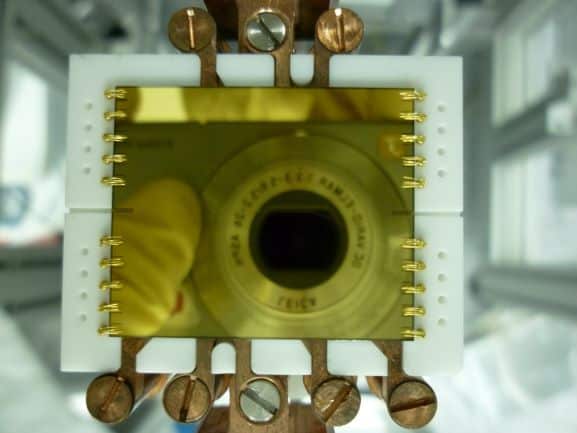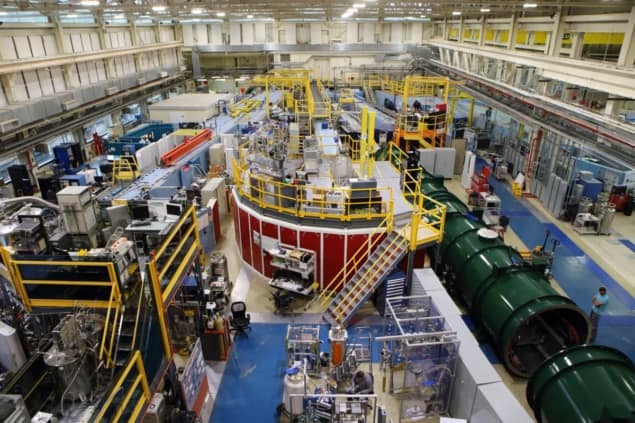Neutron experiment tightens the net around possible fifth force
17 Sep 2021
An improved search for a potential fifth force of nature is one of a trio of new results gleaned from observations of neutron interactions in silicon made by an international team of physicists. The work, which relies on Pendellösung interferometry, also takes a precise look at silicon’s thermal properties and provides a new, independent value for the neutron’s charge radius.
Scattering particles such as X-rays, electrons or neutrons off samples of crystalline materials has for decades provided scientists with valuable information on atomic structure. Quantum mechanics tells us that those particles also behave like waves, and it is the interference between waves deflecting off different points in a crystal lattice that reveals properties such as interatomic spacing.
Straightforward particle scattering has its shortcomings, however. For example, the thermal motion of atoms within crystal samples continually changes the lattice spacing and hence the interference patterns that are created. The consequent loss of accuracy could become a problem when studying silicon and other semiconductor materials at the level needed to understand the behaviour of novel devices operating close to the limits imposed by quantum mechanics.
Standing waves
In the latest work, Benjamin Heacock of the National Institute of Standards and Technology (NIST) in Gaithersburg, Maryland and colleagues in the US, Japan and Canada have better characterized this thermal motion using Pendellösung interferometry. This technique exploits the standing waves created when neutrons enter a sample and interact both with individual atoms ahead and the layers of atoms above and below. Interference between the two sets of standing waves produces oscillations of diffracted intensity whose characteristics reflect the forces experienced by the neutrons as they travel through the crystal.
Pendellösung interferometry was first demonstrated back in the 1940s and has since been implemented using X-rays to measure the density of electrons in silicon. However, the technique’s precision when using neutrons has been limited, partly because neutron sources have lower fluxes than those of X-rays and partly because machining techniques needed to make samples flat also introduce strain.
Heacock and colleagues have found they can minimize strain through the use of modern machining techniques pioneered at the RIKEN Centre for Advanced Photonics in Japan. They were also able to relax the flatness requirement by characterizing samples using what is known as a perfect-crystal neutron interferometer – putting their scheme into practice using cold neutrons from a beamline at NIST’s Center for Neutron Research in Gaithersburg.
Independent vibrations
The researchers used their data in part to better understand how thermal dynamics in silicon can affect X-ray diffraction measurements. As they point out, neutrons provide information complementary to X-ray data. This is because unlike X-rays, which interact with atomic electrons, neutrons interact with atomic nuclei — and because neutrons penetrate more deeply into crystals. The team found that some models based on X-ray data underestimate the size of thermal vibrations. They also discovered that nuclei and their associated electrons may not vibrate as one – as had been previously assumed.
Beyond these data specific to silicon, the researchers also gained new insights into two (real or presumed) universal parameters. One of these is the neutron’s electrical charge radius. Although the neutron is a neutral particle overall, its quark structure confers a slight imbalance in the charge distribution – resulting in a fractionally higher concentration of positive charge near its centre and more negative charge on its edge. The charge radius is the distance between these two points.
As the researchers explain, the inside of a silicon crystal provides an ideal environment to measure this radius given the huge electric fields created by the collection of charges in close proximity to the neutron. Their neutron measurements yielded a mean square charge radius of -0.1101±0089 fm2, which is slightly less precise than the leading values from established experiments that measure neutron transmission through lead or bismuth targets. But they say that their work involves completely different systematic uncertainties and therefore provides an independent measurement – which is particularly valuable, they argue, given a slight inconsistency among existing results.
Fifth force of nature
Perhaps most eye-catching of all, however, are the new bounds that the experiment places on a possible fifth force of nature. Such a force would represent a break with the Standard Model of particle physics, which includes the electromagnetic and strong and weak nuclear forces, but which is widely considered incomplete by physicists owing to outstanding major problems – such as the incompatibility of quantum mechanics and general relativity, as well as the existence of dark matter and dark energy.
No such force has yet been observed but it could potentially take many forms. The generic form probed by Heacock and colleagues is a modification of gravitational interactions known as a Yukawa potential. With their neutron data, the researchers were able to decrease the range of possible interaction strengths at distancebetween 10-8–10-11 m by around an order of magnitude compared to previous experimental searches.READ MORE

Independent experts are enthusiastic about the latest results, with Tamaki Yoshioka of Kyushu University in Japan describing the new-look Pendellösung interferometry as a “very powerful” research tool. Michael Snow of Indiana University Bloomington in the US, meanwhile, reckons there is “still plenty of room” to make the technique more sensitive to possible fifth forces and to develop new kinds of measurements with slow neutrons.
The researchers’ next step is to measure Pendellösung interference over a wider range of symmetry planes within crystals, with the aim of reducing experimental uncertainties by up to a factor of five – in both silicon and germanium. They also have plans for a cryogenic version of their experiment to probe the quantum ground state of atoms. This, they say, could prove particularly fruitful for silicon, given how its quantum ground state determines the material’s electrical properties and anomalous thermal expansion at low temperatures.
The research is described in Science.
from physicsworld,com 17/9/2021

Δεν υπάρχουν σχόλια:
Δημοσίευση σχολίου